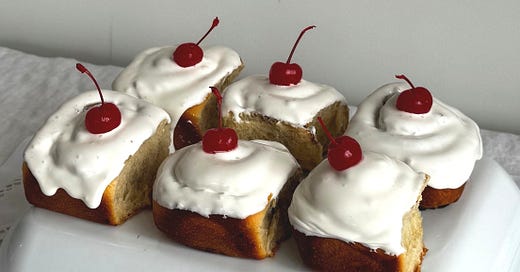In the last issue, we met the first of Britain’s great culinary treasure chests: the school dinner canteen, where young minds are trained on wobbling steamed puddings and thick folds of custard (see Jam Roly-Poly for a hearty reminder). This week, we’ll meet the second: the high street bakery, that non-Newtonian world of shiny buns and fat doughnuts, where cream is piled impossibly high and blobs of jam plump happily atop bright icing and dried fruits pop from every imaginable cranny.
Cast aside any visions of the bakery as a cornerstone of nutrition. It is about as nourishing to the community as the only other establishment you’re guaranteed to find where two or more houses are gathered: the pub. Which is to say, immensely. The high street bakery may have a few loaves and baps on display, but its true purpose is not alimentary. It is something closer to that of a folk song, or a brand new lamb - that puts twinkles back in old eyes and teaches the young that goodness can always be found close at hand.
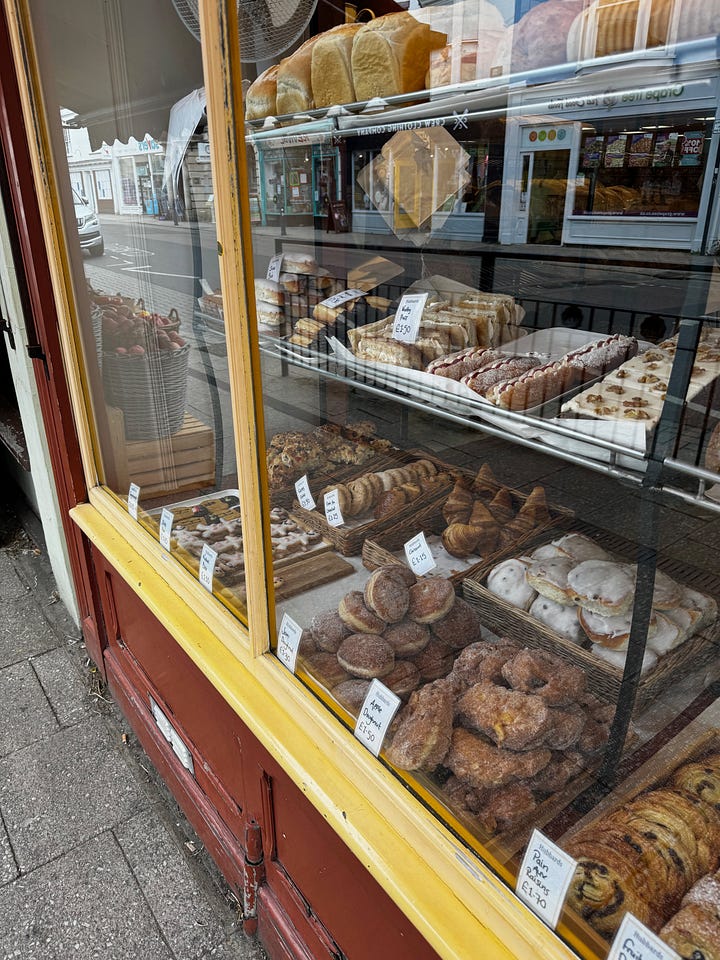
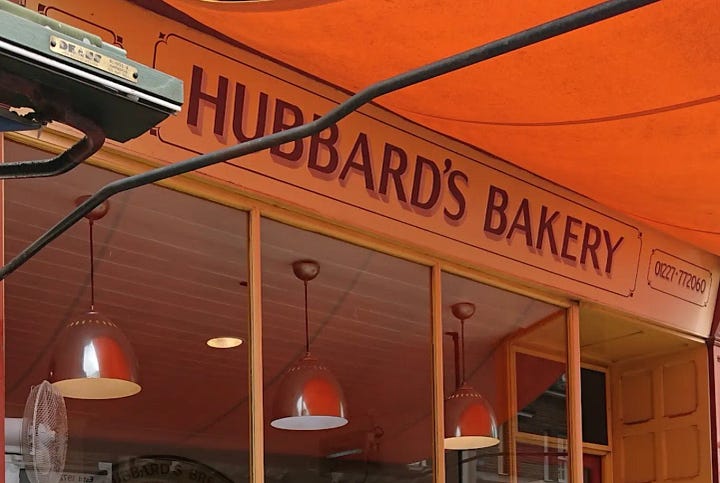
The colour scheme of the high street bakery is invariably brown, red, white, and raisin, which mirrors the breadth of its ingredients. Yet even with so few tools, Britain’s bakeries have created arrow-to-the-heart wonders that will charm the enamel off even the most determinedly joyless of teeth. Each has its regional variations, but there is a core cast of champions that are found almost universally: the jam doughnut, the cream bun, the gingerbread man, the iced finger, the chelsea bun, the jam finger, and finally, the belgian bun.
Of all these, the belgian bun is, in my opinion, the most stunning achievement in bringing cartoon happiness to life. It is a fluffy butter-rich dough spiraled with lemon curd and raisins, coated in a glossy sugar icing and topped with a redder-than-red glaceé cherry. It manages to be both simple and outlandish, a picture of what ‘fancy’ means to our people, and something which - oddly given our dogged cynicism - wouldn’t look unnatural bouncing along in a Disney musical number. Looking out at you from a bakery window, it is an instant reminder of all that’s good in the world, one whose sight compels any set of chompers - milk teeth, adult teeth, no teeth - to sink right in.
The History - a short section
There is no discernible link between the belgian bun and Belgium, only endless reddit threads of Belgians insisting they have “never seen that thing before in my life,” and plenty of French piling on to concur. Food historians remain bemused by the origin of this name, and the best explanation they can offer is that someone in the 19th century thought the name ‘Belgium’ invoked visions of sophistication and quality. I’ll leave that right there.
My own history with the belgian bun is much better known. Like most children, I started life on the kid-friendly, raisin-free iced bun, a pillowy dough finger licked with water icing. Only once I passed my eighth birthday did my parents invite me to try the strong stuff, lest the addition of raisins and a cherry would generate more happiness than my little body could contain. And they were right. While my school friends gnawed happily on simple gingerbread, my bun and I were off in a flight of fancy, high above the world of paving stones and itchy tights and homework, floating on the surety that we were living the highest form of pleasure there is to be known.
The approach
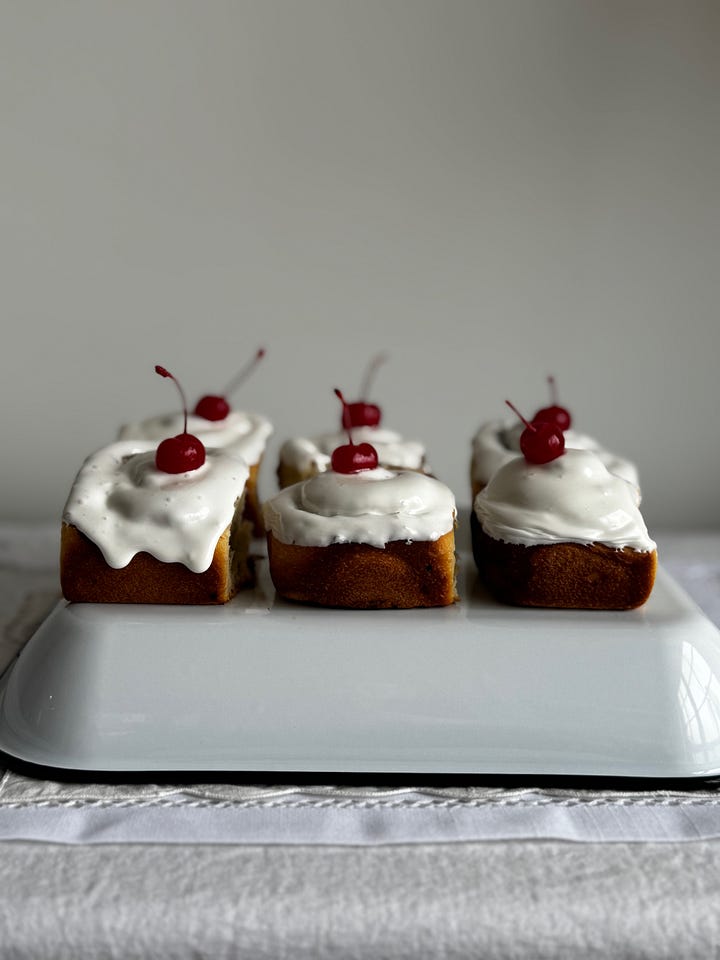
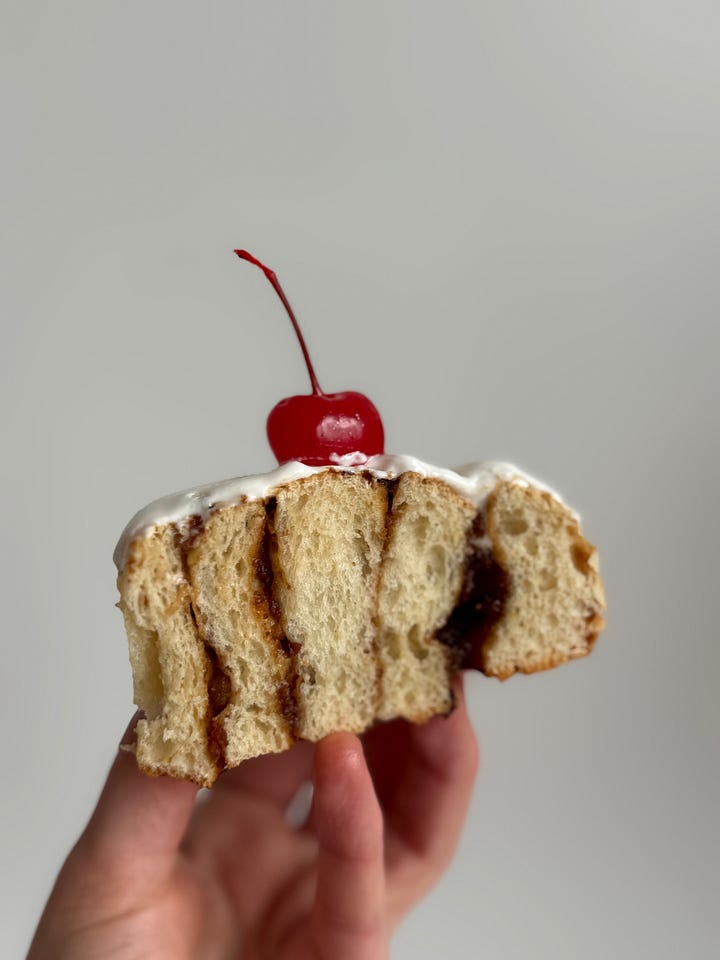
Unlike previous dishes we’ve explored, the belgian bun presents no challenges in the way of esoteric techniques or ingredients. Instead, the difficulty lies in its essential - this pains me to say - uncoolness. It is not natural, or rustic, or remotely healthy. It exists outside all parameters of seasonality and almost all its ingredients are shelf-stable. The combination of lemon curd and raisins is not endorsed by any other advanced civilization, and nowadays the brilliant shock of white icing is more suggestive of chemical bleaching than heavenly sweetness. Add to that, the bun itself has traditionally served more as a packaging solution for the fillings than a feature in its own right, and as a result many recipes produce something on the dense and dry side of acceptable. We can do better.
For my baseline bake, I used Matthew Jones’ recipe from “Bread Ahead: The Expert Home Baker,” which is a perfect non-deviation from the ur bun. This had all the ingredients of the bun of my childhood, but it tasted flat and unsatisfying, and in no way did it exceed the sum of its parts. Maybe I’ve simply eaten more broadly, or developed a palate that can taste more than sugar, but I remember the overwhelming happiness the belgian bun can bring, and I knew it deserved more than this. The only way forward was to tackle this element by element.
The bun: The bun has to be fluffy and rich and delicious all on its own. I want it to squish delicately in my hand and offer the lightest bounce of resistance to my bite. It should have enough flavour that I’m not just searching for the tight, filling-packed middle of the spiral, and it should be TALL. I turned to a wonderful Japanese technique for producing the fluffiest milk buns, tangzhong, a cooked flour and water paste that pre-gelatinizes starch in the flour, allowing it to hold more moisture for longer. I also upped the sugar and salt for flavour, and added a whisper of cinnamon to the dough. At such low levels, cinnamon adds warmth and depth without any detectable taste.
The filling: When I lie awake dreaming of belgian buns I think about the glossy icing, the cherry, and the raisins. I do not think about lemon curd. In my test bake, this was the most puzzling element, and one I’m happy to let go. Still, aware that lemon is a key flavour of the belgian bun, I decided to bring it in elsewhere, as zest in the dough and juice in the filling. Raisins are a must, but I realize that they can be a difficult reminder of oatmeal and sports day lunches, so I decided to keep the ingredient but update the format, opting for a purée of brown-sugar, raisins and dates. This approach has the added bonus of looking more like the friendlier cinnamon bun.
The icing: Here is where I stand my ground. While unpopular, I refuse to deviate from the sugar icing. Most will reject it outright for being grainy and overly sweet, but that’s only because they’ve had poor versions. On belgian buns, the gloss comes from fondant, a milder, more velvety icing typically made with gelatin or shortening added. I use a great shortcut from Lauren Allen of Tastes Better from Scratch which melts marshmallows to replace the lengthy process of gelatinizing sugar. This is what gives the icing its glossy, cartoon drips.
The cherry: No notes! Just please don’t try to be fancy and use something like Luxardo maraschino cherries here. The fire-alarm red is the point.
The recipe
Keep reading with a 7-day free trial
Subscribe to The Buttery to keep reading this post and get 7 days of free access to the full post archives.


